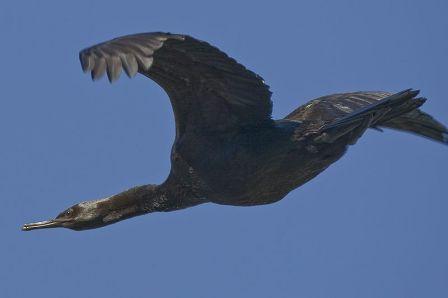The seagull sees farthest who flies highest.
An old Proverb

Pelagic Cormorant: Have you seen this bird?
Pelagic Cormorant
The Pelagic Cormorant (Phalacrocorax pelagicus), also known as Baird’s Cormorant, is a small member of the cormorant family Phalacrocoracidae.
It is also called Pelagic Shag occasionally. This seabird lives along the coasts of the northern Pacific; during winter it can also be found in the open ocean.
The Pelagic Cormorant inhabits the shores and the neritic zone of the North Pacific. Its North American range extends from Alaska to the Baja peninsula in Mexico.
Identification Tips:
• Length: 22 inches Wingspan: 40 inches
• Sexes similar
• Large, dark waterbird with a long, hooked bill and long tail
• Long, thin neck
• Gular region red
• Often perches with wings spread to dry them
Adult:
• Entirely dark plumage except for white flank patch
• Two crests on head
• Thin, white plumes on neck
Immature:
• Very dark plumage
Similar species:
Loons are similar on the water, but lack hooked bills. Most loons hold their bills level while swimming while cormorants hold theirs angled upwards.
It furthermore is found on the Aleutian and other Bering Strait islands, and from the Russian Far East Chukchi Peninsula via Sakhalin south to Kamchatka, and ultimately Ky?sh?.
The subarctic populations are migratory, while the birds from temperate and subtropical regions only disperse locally after breeding, but even so Asian birds may reach China or Korea.
On land, Pelagic Cormorants are rather clumsy and walk with the high-stepped waddling gait typical for all Sulae except darters; after landing they often scratch the ground, as is typical for cormorants. When they feel threatened, they will dart the bills at the intruder, and shake their heads and make a gargling noise.
The Pelagic Cormorant breeds on rocky shores and islands.
This bird forages by swimming to locate prey, then diving and going after it underwater, Typical prey are smallish, bottom-living non-schooling fishes, such as Ammodytes sand eels, sculpins (Cottidae), gunnels (Pholidae) and Sebastes rockfish. Apart from fish, small crustaceans – in particular shrimp – are also often eaten.
The seagull sees farthest who flies highest.
An old Proverb
Bird Quotation Popularity Poll
(4 answers max)
 Loading ...
Loading ...
Add any comments below and/or indicate if you spotted this bird.
The seagull sees farthest who flies highest.
- Flank Plumage | Kalios Hunting And Fishing
- Galapagos Day 2/Morning, July 7: Darwin Bay, Tower Island « Arthur Morris/BIRDS AS ART
- Waddling Gait « Exercise Therapy








